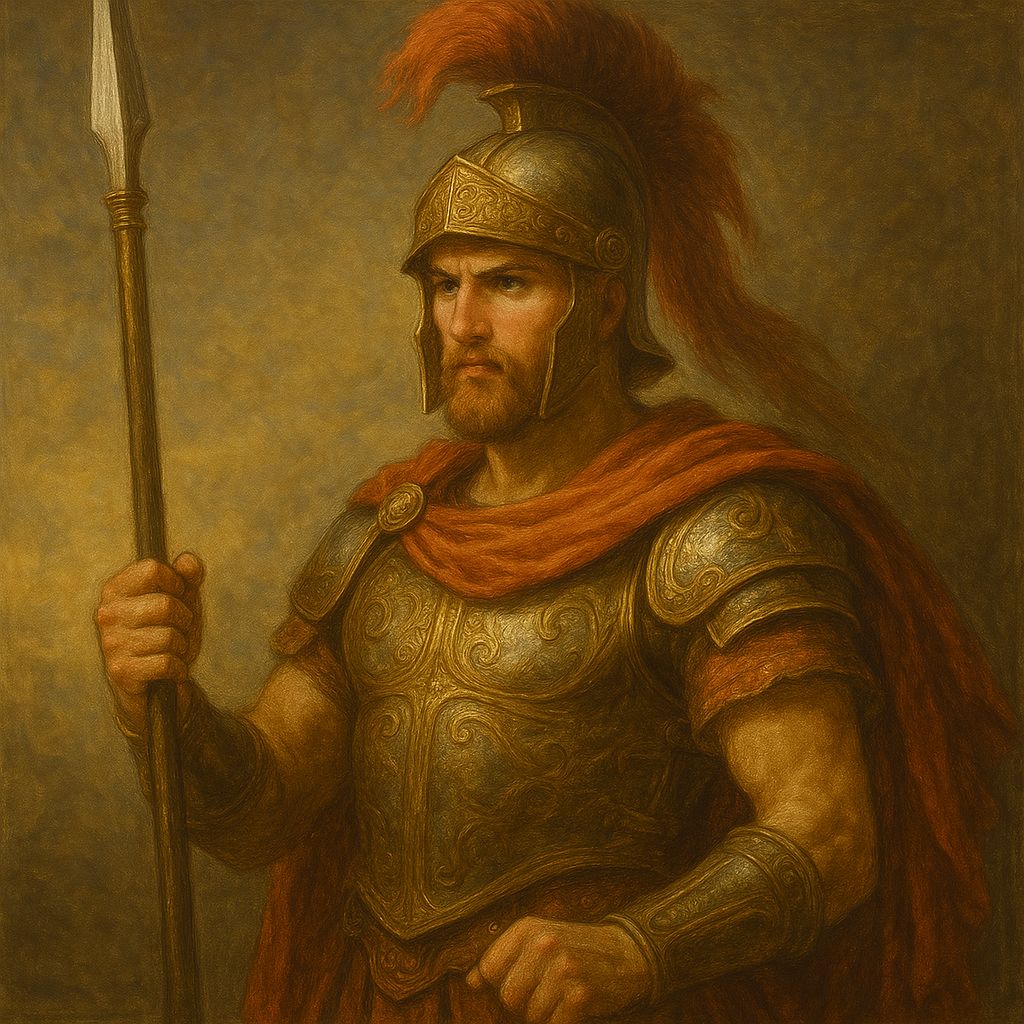Overview
Ares is the ancient Greek god of war, violence, and raw physical aggression. Unlike Athena, who represents strategic warfare and wisdom, Ares embodies the chaotic, untamed force of battle—the bloodlust, fury, and primal courage that arise in conflict. As the son of Zeus and Hera, Ares holds a place among the Olympian gods but is often depicted as a feared and controversial figure, both admired and distrusted by mortals and deities alike. His Roman counterpart is Mars, who took on a more noble and civic persona in Roman tradition.
Origins and Mythology
Ares is one of the twelve Olympians and the son of Zeus (king of the gods) and Hera (queen of the gods). In Greek mythology, he is frequently portrayed as a passionate, impulsive force who charges into battle with little concern for consequences or diplomacy.
While he was worshipped in various parts of Greece, especially in Sparta and Thrace, he was often portrayed negatively in myth, particularly by poets like Homer, who saw him as reckless, destructive, and bloodthirsty.
Despite his aggressive nature, Ares also represents vital aspects of masculinity, such as bravery, endurance, and the will to fight for survival and honor.
Symbols and Iconography
Ares is typically portrayed as a powerful, armored warrior, youthful and vigorous, often in motion.
Common Symbols
- Spear and Shield – Representing battle readiness and defense
- Helmet – Symbolizing war and confrontation
- Torch – A sign of destruction and chaos
- Vulture and Dog – Animals sacred to Ares, associated with war, death, and scavenging
- Chariot – Often drawn by fierce, fire-breathing horses into battle
He is frequently depicted:
- Wearing bronze armor, sometimes with a red or blood-stained cloak
- In scenes of combat, conquest, or romantic entanglement, especially with Aphrodite
Attributes and Powers
1. God of Physical Warfare and Bloodlust
Ares governs the raw, brutal, and emotional side of war. He represents the violence and chaos that erupt during conflict and the adrenaline-fueled desire to fight.
2. Embodiment of Courage and Combat Prowess
While sometimes mocked or criticized by other gods, Ares also embodies strength, courage, and persistence in the face of danger—qualities admired by warriors and soldiers.
3. Lover of Aphrodite
Ares is famously the lover of Aphrodite, goddess of love and beauty. Their affair, though scandalous, highlights the interplay of passion and violence, love and war. From their union came several divine children, including:
- Phobos (Fear)
- Deimos (Terror)
- Harmonia (Harmony)
- Eros (in some versions)
These offspring reflect the emotional spectrum surrounding warfare and desire.
4. Patron of Warriors and Combatants
Despite his volatile nature, Ares was invoked by soldiers, athletes, and those seeking strength and endurance. His energy is one of direct action, resilience, and fearless confrontation.
Key Myths and Stories
Ares and the Aloadae Giants
Ares once fought the twin giants Otus and Ephialtes, who challenged the gods. He was captured and imprisoned in a bronze jar for over a year before being rescued—an unusual tale that highlights his vulnerability.
The Adultery with Aphrodite
While Aphrodite was married to Hephaestus, the god of craftsmanship, she engaged in a passionate affair with Ares. Hephaestus crafted a golden net and caught the lovers in the act, exposing them to the ridicule of the other gods. This tale shows Ares’s passion, impulsiveness, and disregard for convention.
Ares in the Trojan War
In Homer’s Iliad, Ares supports the Trojan side, fighting alongside Hector and others. However, he is injured by the hero Diomedes, with help from Athena, and returns to Olympus in pain—an example of his frequent defeat by more strategic forces.
Temples and Worship
While Ares was not as widely worshipped as other Olympians like Athena or Apollo, he had important cult sites, especially in militaristic regions.
Major Cult Centers
- Thrace – Considered Ares’s homeland; a region associated with warriors and wild nature
- Sparta – Where martial virtues were central, Ares was invoked in battle rites and sacrifices
- The Areopagus (Athens) – A hill named after Ares, where he was tried by the gods for murder; later became a court for homicide cases
Rituals
- Offerings of blood, armor, and weapons
- Prayers for victory, strength, and protection in battle
- Sacrifices of animals, especially dogs, and the dedication of enemy arms after combat
Spiritual and Archetypal Significance
In modern spiritual and psychological interpretation, Ares represents:
- The Warrior Archetype – Courage, action, discipline, and the will to protect
- The Shadow Side of Aggression – Rage, violence, selfishness, and destruction
- Masculine Energy in its primal form – Physicality, competitiveness, and dominance
- The power of confrontation and direct expression when tempered with awareness
Ares may be invoked or reflected upon in:
- Moments requiring bravery, confrontation, or self-assertion
- Work with anger, passion, and personal boundaries
- Rituals for protection, martial skill, or strength in adversity
Conclusion
Ares, god of war and raw power, reveals the primal energy of conflict—its dangers, passions, and potential for transformation. He stands as both a cautionary figure and a source of strength, reminding us that unbridled force can destroy, but channeled power can protect and liberate. In honoring Ares, we acknowledge the part of ourselves that dares to fight, defend, and act without hesitation—while also learning to temper it with wisdom and purpose.

